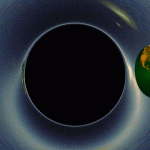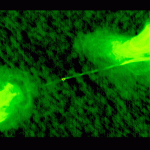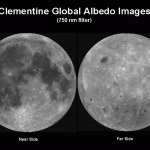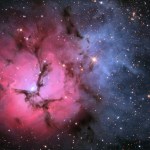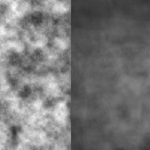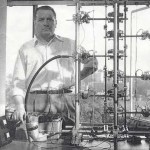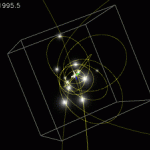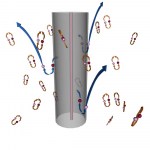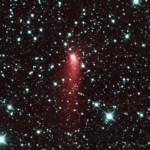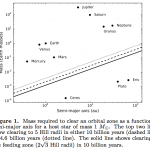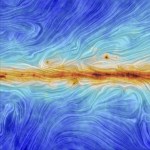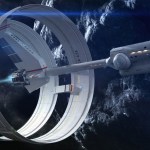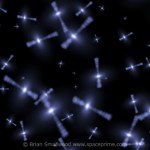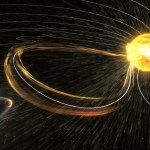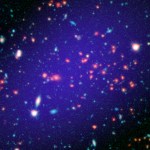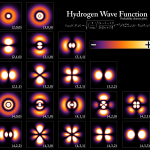
“Science is the one human activity that is truly progressive. The body of positive knowledge is transmitted from generation to generation.” -Edwin Hubble
We really got into some wondrous stuff here at Starts With A Bang this past week, including:
Can we see our galaxy's supermassive black hole? (for Ask Ethan),
Averaging inanimate objects can produce human faces,
A tribute to the greatest French nebula in space (for Mostly Mute Monday),
Can we test dark energy using the Solar System?,
The moon's two sides look so different thanks to 4.5 billion year old physics,
and…
"Twinkle, twinkle quasi-star.
Biggest puzzle from afar.
How unlike the other ones.
Brighter than a billion suns.
Twinkle, twinkle, quasi-star.
How I wonder what you are." -George Gamow
One of the most interesting classes of objects in the entire sky is one that's invisible to the naked eye, yet appears brighter than anything else in radio wavelengths: the quasar. Originally coined as an acronym (QSRS) for Quasi-Stellar Radio Source, these were later determined to be incredibly energetic sources of accelerated matter powered by a supermassive black hole.
Image credit: Aurore Simonnet, NASA /…
"Equipped with his five senses, man explores the universe around him and calls the adventure Science." -Edwin Hubble
Back in the 1920s, Einstein's general relativity had just come out and gained acceptance, and a debate was raging over whether the spirals in the sky were within our own galaxy, or were entire galaxies unto themselves.
Image credit: E. Hubble, NASA, ESA, R. Gendler, Z. Levay and the Hubble Heritage Team, via http://apod.nasa.gov/apod/ap110701.html.
Not only did Edwin Hubble put that debate to rest, discovering that they were galaxies, but he measured their distances and…
“Cheap little rhymes
A cheap little tune
Are sometimes as dangerous
As a sliver of the moon.” -Langston Hughes
4.5 billion years ago, a giant object collided with our proto-Earth, kicking up debris that eventually coalesced into the Moon.
Image credit: NASA/JPL-Caltech.
While the near side contains dark maria and lunar lowlands, the far side is almost exclusive heavily cratered, high-mountainous regions. This was a mystery for a long time, but it appears that heating from the hot, young Earth caused a chemical and crustal difference between the two faces.
Images credit: NASA / JPL-Caltech…
"There are still so many questions to answer. When you look at any part of the universe, you have to feel humbled." -Saul Perlmutter
Discovered in 1998 from the observation of distant supernovae, dark energy determines the eventual fate of the Universe, leading to a "Big Freeze" scenario, where all the galaxies, groups and clusters that are presently gravitationally unbound from one another will eventually recede away until they're unreachable.
Image credit: NASA & ESA, via http://www.spacetelescope.org/images/opo9919k/.
But if dark energy truly permeates all of space as a…
"Truth is more valuable if it takes you a few years to find it." -Jules Renard
Of all the star-forming nebulae in our galaxy, the Trifid Nebula -- Messier 20 -- is thought to be the newest and youngest. Named "Trifid" for its threefold appearance, the blue reflection nebula, the red emission nebula, and the dark, star-forming dust lanes, it also bears a resemblance to the French tricolor flag.
Image credit: flickr user Marc Van Norden, via https://www.flickr.com/photos/mvannorden/8275065973/in/photostream/.
Because of the large number of young, hot stars still inside, the Trifid Nebula is…
"Every great work makes the human face more admirable and richer, and that is its whole secret." -Albert Camus
It's well known that by aligning and averaging a wide variety of human faces together, an eerie "average" human face can be arrived at. But we see faces in things all the time, from natural scenes like terrain to artificial ones like cars, coffeemakers and combination locks.
Images credit: Instagram, via the hashtag #FacesInThings, retrieved from Robby Kraft at http://robbykraft.com/sfpc/index.php?controller=post&action=view&id_pos….
For the first time, someone …
“You are all wave particles when I close my eyes. I am no more entranced by your entanglement than a butterfly is to a bee.” -Solange nicole
This past week at Starts With A Bang saw a flurry of activity, including a wonderful variety of new stories, like:
Would a scientist bet their life on a theory? (for Ask Ethan),
The EM Drive, NASA's 'impossible engine,' highlights our greatest failing,
Stunning visualizations of our galaxy's magnetic field (for Mostly Mute Monday),
Scientists redefine planet to include exoplanets, and it works beautifully,
Keeping Better Time…
"Never look down to test the ground before taking your next step; only he who keeps his eye fixed on the far horizon will find the right road." -Dag Hammarskjold
One of the great discoveries of the past few decades was that of a supermassive black hole at the center of our Milky Way. No longer was it mere conjecture or unverified theory; observations in the X-ray, infrared, radio, and of stars orbiting a central, non-luminous point all indicate the presence of a 4 million solar mass black hole at a location known as Sagittarius A*.
Image credit: X-ray: NASA/UMass/D.Wang et al., IR: NASA/…
"It's not the job of the theorist to defend his model at all costs!" - Joel Primack
One of the more puzzling phenomena in our quantum Universe is that of entanglement: two particles remain in mutually indeterminate states until one is measured, and then the other — even if it's across the Universe — is immediately known.
Image credit: Ulf Leonhardt.
In theory, this should be true even if one member of the pair falls into a black hole, although it's impossible to measure that. However, we can (and have) measured that for the laboratory analogue of black holes, known as "dumb holes," and the…
"I have worn myself thin trying to find out about this comet, and I know very little now in the matter." -Maria Mitchell
Originating from the Kuiper belt and the Oort cloud, comets are generally thought of as periodic objects, with their initial trajectories having been perturbed by either Neptune, another distant object or a passing star or rogue planet.
Image credit: ESA/Rosetta/NAVCAM.
But most comets aren't periodic; they're transient instead, where a trip into the inner Solar System gives them additional gravitational perturbations, causing them to either fly into the Sun or gain…
"Some kind of celestial event. No — no words. No words to describe it. Poetry! They should have sent a poet. So beautiful. So beautiful... I had no idea." -Dr. Ellie Arroway, Contact
Back in 2006, the International Astronomical Union defined the term "planet" for the first time by three criteria: its ability to orbit the Sun, to pull itself into hydrostatic equilibrium, and to clear its orbit. This not only excluded all exoplanets, but it set up impractical criteria for measuring exoplanet properties.
Image credit: ESO.
But UCLA scientist Jean-Luc Margot found a new planetary test…
"It is true that we are made of dust. And the world is also made of dust. But the dust has motes rising." -Muhammad Iqbal
If you want to view the Milky Way in all its true splendor, you need to go beyond visible light, as the cosmic dust that gives rise to new stars also absorbs visible light, robbing us of a view of our galaxy. But those other wavelengths that are more transparent to the dust -- infrared and microwave -- are absorbed by Earth's atmosphere. If we want to see what's going on, we've got to go to space.
Image credit: ESA and the Planck Collaboration.
With nine different…
"For a successful technology, reality must take precedence over public relations, for nature cannot be fooled." -Richard Feynman
Every few months now, the popular press goes wild with claims that there’s a new engine out there, one that produces thrust without any exhaust, violating the fundamental law of conservation of momentum.
Image credit: NASA Spaceflight forums, via Chris Bergin.
While science is, fundamentally, an experimental endeavor, this is far, far more likely to be a case of our own, human failings than it is a case of revolutionary new physics. There are distinct patterns…
“It is better to have your head in the clouds, and know where you are... than to breathe the clearer atmosphere below them, and think that you are in paradise.” -Henry David Thoreau
Every week at Starts With A Bang is special, but we made an amazing move, over to Forbes, which is the new home of our blog! Starting on November 2nd, we made our move, and as the month unfolds, we'll be bringing all-new content over there, to be republished (ad-free) on Medium the next week. Here's the good stuff, just in case you missed anything:
The very, very end of the Universe (for Ask Ethan…
"In theory, there's no difference between theory and practice. In practice, there is." -Yogi Berra
Scientific theories are a dime a dozen, yet only the most successful have a large range of validity, hold up to many disparate lines of evidence, and stand the test of time. Inevitably, our explorations go beyond that range of validity, and a new theory must come along to supersede them.
Image credit: NASA / STScI / A. Felid.
But does that invalidate the old theory? And does that mean it would be irresponsible to bet your life that the idea you're working on is correct? While no theory can…
"Studying whether there's life on Mars or studying how the universe began, there's something magical about pushing back the frontiers of knowledge. That's something that is almost part of being human, and I'm certain that will continue." -Sally Ride
If you came to the Solar System some 500 million years after its formation, you would've found two world with oceans of liquid water, continents and all the conditions we know of for life to begin thriving: Earth and Mars. But unlike our own world, Mars' organic history was cut short when it lost its atmosphere and became a barren, desert…
"Based on our understanding of how galaxy clusters grow from the very beginning of our universe, this cluster should be one of the five most massive in existence at that time." -Peter Eisenhardt
While deep galaxy surveys from telescopes like Hubble are great for identifying distant individual galaxies, they're not wide-field enough to find massive clusters. Similarly, wide-field surveys like SDSS don't go deep enough to find the most distant clusters.
Image credit: NASA/JPL-Caltech/UCLA, for the WISE mission.
But thanks to the all-sky infrared survey performed by NASA's WISE mission,…
"Historically, when we have better clocks, we have better navigation." -David Wineland
If you want to keep time in the Universe, you need a reference point that everyone can agree on, so that when you talk about things like "meters," "seconds," or "the speed of light," everyone else in the world is in agreement. In addition, you need a reproducible standard, where anyone can measure the same ticking phenomenon.
Image credit: Wikimedia Commons user PoorLeno.
In the case of our Universe, atomic clocks are the best standard of all, although they didn't reach that point until a generation…
"This scenario implies that the giant planet instability is not the source of the Late Heavy Bombardment and that terrestrial planet formation finished with the giant planets in their modern configuration." -Nathan A. Caib & John E. Chambers
It's a common but nonetheless spectacular occurrence when our leading scientific theories -- the ones with the best explanations for the observed phenomena -- run into conflict with what we see. Sometimes, it's the power of simulations that show us the way.
In 2005, scientists put forth the "Nice Model" to explain the configuration of the Solar…
